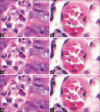Optimized JPEG 2000 Compression for Efficient Storage of Histopathological Whole-Slide Images
- PMID: 29910969
- PMCID: PMC5989536
- DOI: 10.4103/jpi.jpi_69_17
Optimized JPEG 2000 Compression for Efficient Storage of Histopathological Whole-Slide Images
Abstract
Background: Whole slide images (WSIs, digitized histopathology glass slides) are large data files whose long-term storage remains a significant cost for pathology departments. Currently used WSI formats are based on lossy image compression alogrithms, either using JPEG or its more efficient successor JPEG 2000. While the advantages of the JPEG 2000 algorithm (JP2) are commonly recognized, its compression parameters have not been fully optimized for pathology WSIs.
Methods: We defined an optimized parametrization for JPEG 2000 image compression, designated JP2-WSI, to be used specifically with histopathological WSIs. Our parametrization is based on allowing a very high degree of compression on the background part of the WSI while using a conventional amount of compression on the tissue-containing part of the image, resulting in high overall compression ratios.
Results: When comparing the compression power of JP2-WSI to the commonly used fixed 35:1 compression ratio JPEG 2000 and the default image formats of proprietary Aperio, Hamamatsu, and 3DHISTECH scanners, JP2-WSI produced the smallest file sizes and highest overall compression ratios for all 17 slides tested. The image quality, as judged by visual inspection and peak signal-to-noise ratio (PSNR) measurements, was equal to or better than the compared image formats. The average file size by JP2-WSI amounted to 15, 9, and 16 percent, respectively, of the file sizes of the three commercial scanner vendors' proprietary file formats (3DHISTECH MRXS, Aperio SVS, and Hamamatsu NDPI). In comparison to the commonly used 35:1 compressed JPEG 2000, JP2-WSI was three times more efficient.
Conclusions: JP2-WSI allows very efficient and cost-effective data compression for whole slide images without loss of image information required for histopathological diagnosis.
Keywords: Digital pathology; JPEG 2000; image compression; virtual microscopy; whole-slide imaging.
Conflict of interest statement
There are no conflicts of interest.
Figures




References
-
- Huisman A, Looijen A, van den Brink SM, van Diest PJ. Creation of a fully digital pathology slide archive by high-volume tissue slide scanning. Hum Pathol. 2010;41:751–7. - PubMed
LinkOut - more resources
Full Text Sources
Other Literature Sources

